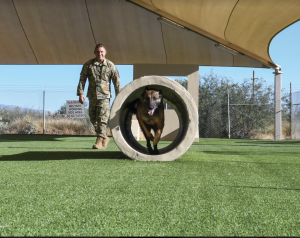In Reid’s work as a senior MWD trainer, the dogs are trained and certified for single and dual purposes. Those consist of detection and patrol.
Ancient authors such as Pliny the Elder have written about a number of breeds used by the Roman Army during the empire’s expansion and the various roles the animals played. Among the favorites for sheer strength and size were the Cane Corso and the Molossian, a likely ancestor of the Neapolitan Mastiff.
During Julius Caesar’s invasion f Britain in 55 BCE, he was met with opposition from Celtic warriors accompanied by their own fearsome canines. In Medieval times it wasn’t unusual for dogs to accompany knights on years-long religious crusades.
Fast-forward to the early 20th century, and a Belgian Malinois named Taki would become the first dog to be used as a messenger in World War I. Another notable canine during the period was Sergeant Stubby (1916-1926), the unofficial mascot of the 102nd Infantry Regiment assigned to the 26th (Yankee) Division. He served for 18 months and participated in 17 battles on the Western Front. He’s said to have saved his regiment from mustard gas attacks, located and comforted the wounded and allegedly caught a German soldier by the seat of his uniform and held him until American GIs arrived. Stubby’s been called the most decorated war dog of WWI and the only dog to be nominated and promoted to sergeant through combat. He played such a notable role in history that his remains are in the Smithsonian today.
In World War II, Belgian sheepdogs were again used as message carriers, Red Cross dogs and defense dogs. At the same time, there were the United States Marine Corps’ “Devil Dog” War Dog Platoons, which served in the Pacific. Made up predominantly of Dobermans, the Devil Dogs trained for military service first in Cuba and then at the Marine War Dog Detachment Training School at Camp Lejeune, North Carolina. They were joined there by a boxer named Fritz, reportedly the very first dog sworn and signed into the Marine Corp. They acted as messengers, sentries and scouts and would eventually include German shepherds, labs and other breeds. Beginning their service as privates, after five years they could work their way up to a Master Gunner Sergeant, eventually outranking their handlers.
In the 1960s, U.S. soldiers continued to work with Dobermans and shepherds in Vietnam. While their roles throughout history have been varied, canines have traditionally been considered too valuable to send into battle. Because of this, they’ve come in all shapes and sizes. There was even a four-pound Yorkie named Smoky that aided troops in WWII and later became the world’s first therapy dog on record. For the most part, the work of military dogs has included guarding, detaining and detection.
Military dog trainer Josh Reid carries on the tradition. Tech Sgt. Reid is stationed at Davis-Monthan Air Force Base in Tucson. As part of the 355th SFS, his love of dogs and the desire to work with them has been a lifelong journey beginning with a canine demonstration he witnessed as a kid at the Selfridge Air National Guard Base in Michigan. Originally from Clinton Township, he joined the Air Force in August 2007. In addition to three overseas tours, he’s been stationed in Colorado, Ohio, and North Carolina before eventually coming to Arizona.
During his 14 years in the Armed Forces, 10 have been spent with canines. Reid started out as a handler before moving up to the position of trainer and then on to becoming a Kennel Master. His work with Military Working Dogs (MWD) centers around teaching the animals a technique known as Bite and Hold, in which canines latch onto a subject until a handler can apply cuffs.
MWDs are not trained to kill. Rather, they are taught to bite specific parts of the body, such as the chest, back, arms or legs of the individual they are to detain until they are ordered to release. A proper bite consists of all four canine teeth making contact. The move is known as a full-mouth bite, and it’s extremely effective for incapacitating fleeing suspects or potential threats.
In order to elicit this response, military decoys are deployed in protective gear to ensure no harm comes to them and the dogs are praised for the level of accuracy they achieve in the obedience yard. But first, there’s a dog boot camp at Lackland AFB in San Antonio, Texas, where initial training occurs. TSgt. Reid says that the animals can “wash out,” if they don’t meet the criteria for the program. It’s the same with all service-dog training. Not all dogs are suited to particular tasks, but it doesn’t mean they can’t perform well in other, equally important, roles.
In Reid’s work as a senior MWD trainer, the dogs are trained and certified for single and dual purposes. Those consist of detection and patrol. With detection, the dogs are searching for explosives or narcotics. Both groups are taught the Bite and Hold maneuver by Reid and his decoy helpers.
Last year, Reid competed in the Arizona Law Enforcement Canine Association’s annual Desert Dog Trials in Scottsdale. “The purpose of the gathering was to bring together the best law enforcement canine programs in order to share experience, develop tactics and advance their training.”
He also added that there’s the aspect of friendly competition between the teams to see who the best dogs in Arizona are. With training and competition, air personnel from the 355th Security Forces Squadron MWD team are able to enhance the ability to defend the base and ensure the safety of all service members on the installation. FBN
By Rebecca West







